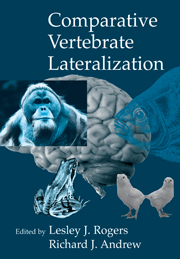Book contents
- Frontmatter
- Contents
- List of Contributors
- Preface
- Introduction
- Part one Evolution of lateralization
- Part two Development of lateralization
- 5 Behavioural development and lateralization
- 6 Factors affecting the development of lateralization in chicks
- 7 Ontogeny of visual asymmetry in pigeons
- 8 Development of laterality and the role of the corpus callosum in rodents and humans
- 9 Posture and laterality in human and non-human primates: Asymmetries in maternal handling and the infant's early motor asymmetries
- Part three Cognition and lateralization
- Part four Lateralization and memory
- Epilogue
- Author Index
- Subject Index
- Richard Andrew
6 - Factors affecting the development of lateralization in chicks
Published online by Cambridge University Press: 10 December 2009
- Frontmatter
- Contents
- List of Contributors
- Preface
- Introduction
- Part one Evolution of lateralization
- Part two Development of lateralization
- 5 Behavioural development and lateralization
- 6 Factors affecting the development of lateralization in chicks
- 7 Ontogeny of visual asymmetry in pigeons
- 8 Development of laterality and the role of the corpus callosum in rodents and humans
- 9 Posture and laterality in human and non-human primates: Asymmetries in maternal handling and the infant's early motor asymmetries
- Part three Cognition and lateralization
- Part four Lateralization and memory
- Epilogue
- Author Index
- Subject Index
- Richard Andrew
Summary
Introduction
Over the last two decades, it has been well established that there are a variety of forms of structural and functional lateralization in a number of avian species, including chicks (reviewed by Andrew, 1988, 1991; Rogers, 1995, 1996), pigeons (Güntürkün, 1997b), canaries (Nottebohm, 1977), zebra finches (Alonso, 1998) and marsh tits (Clayton and Krebs, 1994). Among these avian species, the chick, Gallus gallus domesticus, has been used as a model to study how hormones and early experience interact to influence the development of brain lateralization. In this chapter we review a number of studies that have examined the influence of light exposure prior to hatching and of steroid hormones on the development of asymmetry of the visual pathways and lateralization of visual behaviour.
Although the chick has been used extensively in studies of learning, memory formation, visual lateralization and visual neurone development, knowledge of the organization of the visual pathways in the chick is limited. Until recently, most knowledge of the organization of avian visual pathways came only from studies of the pigeon (reviewed by Güntürkün et al., 1993; Bischof and Watanabe, 1997), and it was generally assumed that the visual system of chicks had the same organization as that of the pigeon or one very similar to it. However, our recent studies have shown there are some clear differences between the chick and the pigeon in the organization of the central visual pathways (Deng and Rogers, 1998a, 1998b).
- Type
- Chapter
- Information
- Comparative Vertebrate Lateralization , pp. 206 - 246Publisher: Cambridge University PressPrint publication year: 2002
- 18
- Cited by

